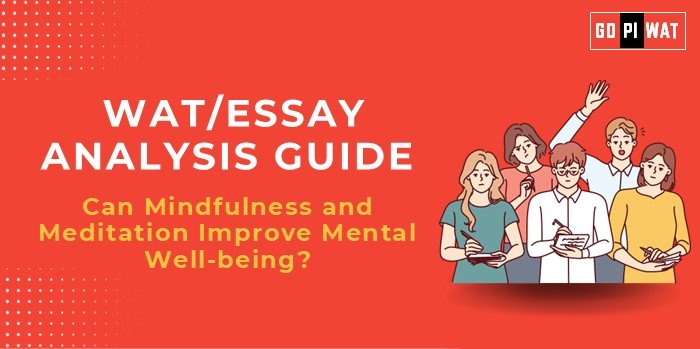📋 WAT/Essay Analysis Guide: Can Mindfulness and Meditation Improve Mental Well-being?
🌐 Understanding the Topic’s Importance
Mindfulness and meditation intersect with mental health, productivity, and healthcare costs, making it a multifaceted topic for B-schools focusing on leadership, stress management, and organizational health.
⏳ Effective Planning and Writing
- Time Allocation:
- 📝 Planning: 5 minutes
- ✍️ Writing: 20 minutes
- 🔍 Reviewing: 5 minutes
- Preparation Tips:
- 📊 Highlight statistics, such as workplace productivity boosts and clinical success rates.
- 👥 Identify key stakeholders, including corporations, governments, and healthcare providers.
💡 Introduction Techniques for Essays
-
- Contrast Approach:
“While mindfulness has been scientifically validated, many individuals struggle with consistent adherence, raising questions about its universal applicability.”
-
- Solution-Based Approach:
“Meditation programs in schools and workplaces could bridge the mental health gap, fostering societal well-being.”
📖 Structuring the Essay Body
- Achievements:
- ✅ Programs like Mindfulness-Based Stress Reduction (MBSR) show a 70% success rate in reducing PTSD symptoms, highlighting therapeutic benefits.
- 📈 Improved workplace productivity and employee well-being in companies like Google and SAP that promote mindfulness initiatives.
- Challenges:
- ⚠️ Limited access in rural areas and underserved communities restricts the reach of mindfulness programs.
- 🚧 Cultural barriers and skepticism hinder acceptance in certain demographics.
- Future Outlook:
- 📱 Digitization of mindfulness tools, such as apps and virtual programs, to make them more accessible.
- 🤝 Public-private partnerships to subsidize and implement mindfulness programs at a national scale.
- 📚 Integration into school curriculums to instill lifelong mental health practices from an early age.
📄 Concluding Effectively
-
- Balanced Perspective:
“Mindfulness and meditation hold promise for improving mental health but must overcome accessibility barriers to realize their full potential.”
-
- Global Comparison:
“As countries like India and Japan integrate mindfulness into culture and workspaces, scaling similar models worldwide could address mental health crises effectively.”
📊 Analyzing Successes and Shortcomings
- Key Achievements:
- ✅ Widespread adoption of mindfulness apps like Calm and Headspace, making mental well-being accessible globally.
- 📜 Scientific validation of meditation’s efficacy in reducing anxiety, depression, and stress.
- Challenges:
- ⚠️ Accessibility gaps in rural and economically weaker sections.
- 📉 Adherence issues, as individuals often struggle to maintain consistent mindfulness practices.
- Global Context:
- 🇮🇳 India’s cultural integration of yoga and meditation serves as a model for mental health strategies.
- 🇯🇵 Japan’s corporate mindfulness programs emphasize stress reduction and employee well-being.
🚀 Recommendations for Sustainable Progress
- 📚 Introduce Mindfulness Programs in Schools: Educate students early to normalize mental health practices.
- 📱 Subsidize Digital Platforms: Support app-based mindfulness programs to increase accessibility.
- 🤝 Collaborate with NGOs: Partner with organizations to implement mindfulness initiatives in rural areas.
✍️ Sample Short Essays
-
- Balanced Perspective:
“While mindfulness has proven benefits, its success hinges on overcoming systemic barriers like access and adherence. With targeted initiatives, it can play a transformative role in mental health improvement.”
-
- Solution-Oriented:
“Meditation in schools and workplaces can revolutionize mental health, provided scalability and cultural inclusivity challenges are addressed effectively.”
-
- Global Comparison:
“As countries integrate mindfulness into national strategies, its global expansion could effectively combat rising mental health challenges and promote societal well-being.”


